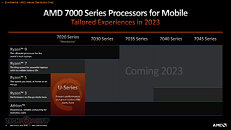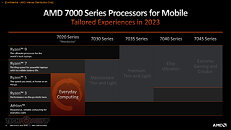- Joined
- Oct 9, 2007
- Messages
- 47,230 (7.55/day)
- Location
- Hyderabad, India
| System Name | RBMK-1000 |
|---|---|
| Processor | AMD Ryzen 7 5700G |
| Motherboard | ASUS ROG Strix B450-E Gaming |
| Cooling | DeepCool Gammax L240 V2 |
| Memory | 2x 8GB G.Skill Sniper X |
| Video Card(s) | Palit GeForce RTX 2080 SUPER GameRock |
| Storage | Western Digital Black NVMe 512GB |
| Display(s) | BenQ 1440p 60 Hz 27-inch |
| Case | Corsair Carbide 100R |
| Audio Device(s) | ASUS SupremeFX S1220A |
| Power Supply | Cooler Master MWE Gold 650W |
| Mouse | ASUS ROG Strix Impact |
| Keyboard | Gamdias Hermes E2 |
| Software | Windows 11 Pro |
AMD today launched the Ryzen 7020 and Athlon 7020 lines of entry-level mobile processors that pack a unique combination of AMD processor, graphics, and I/O technologies that promise a superior experience and battery-life in the entry-level notebook segment that's usually forsaken by processor manufacturers. Based on the 6 nm "Mendocino" monolithic silicon, these SoC pack a 4-core/8-thread CPU based on an enhanced version of the "Zen 2" microarchitecture; an entry-level iGPU based on the latest RDNA2 graphics architecture, with modern display I/O and media-acceleration features; and a modern I/O that includes support for LPDDR5 memory. Processors in the series offer TDP in the range of 8 to 15 W, making them "U-segment" chips but in "H-segment" form-factors. AMD is promising battery-life of up to 12 hours on the full charge.
The 6 nm "Mendocino" silicon packs a single "Zen 2" CCX with four CPU cores, each with 512 KB of dedicated L2 cache, and 4 MB of shared L3 cache. Infinity Fabric connects it with the iGPU, which AMD markets as Radeon 610M. This iGPU packs two RDNA2 compute units (128 stream processors). AMD feels this is enough for everyday computing, web-browsing, and online videos. Its display engine is contemporary, with support for modern notebook display types; while the media engine offers hardware-accelerated decode for H.265 (HEVC), H.264, and AV1, among several older video formats. There are several platform features that Windows 11 can take advantage of, including modern standby, wake-on-voice, including Cortana and Alexa support; Microsoft Ink, and Microsoft Modern Device power-management. Its hardware security features include Pluton, and secure bio channel, making the chips fully capable of running Windows 11 in a commercial environment.




There are three processor models AMD is launching today, these include the Ryzen 5 7520U, the Ryzen 3 7320U, and the Athlon Gold 7220U. All three feature the same Radeon 610M iGPU, and TDP in the range of 8 to 15 W, with the same platform and I/O features. The Ryzen 5 7520U leads the pack with a 4-core/8-thread CPU clocked at 2.80 GHz with 4.30 GHz boost. The Ryzen 3 7320U is clocked slightly below, while retaining the core-configuration. It comes with CPU clock speeds of 2.40 GHz, and a boost frequency of 4.10 GHz. The Athlon Gold 7220U is a dual-core chip, with a 2-core/4-thread CPU clocked at 2.40 GHz, boosting up to 3.70 GHz.

AMD is working to improve the device experience of entry-level mainstream notebooks, and worked with at least three notebook manufacturers to ensure the user gets faster boot times, faster application performance, contemporary I/O, and most importantly, the 12-hour battery life. Lenovo, HP, and Acer are onboard with AMD on this, and are ready with three products—Lenovo Ideapad 1 (around the 14-inch mark), an unnamed HP 17-inch notebook, and the Acer Aspire 3 (around the 15-inch mark). These devices should start launching in Q4-2022.


In its performance benchmarks for the chips, AMD compared the Ryzen 3 7320U with the Intel Core i3-1115G4 "Tiger Lake-U," 2-core/4-thread albeit at a comparable price-point. The 7320U was shown with 31% higher scores in PCMark 10; 58% higher scores in Cinebench R23, and 80% higher performance in 7-zip. The PCMark 10 "app start" test shows the 7320U score 31% higher. AMD is recommending its partners to include at least an entry-level BGA NVMe SSD with their notebooks, which could be playing a major role with app-launch times.


AMD in its presentation also confirmed that 2023 will be when the company debuts "Phoenix," its next-generation mobile SoC that packs "Zen 4" CPU cores, and RDNA3 graphics; as well as the 7045-series "Dragon Range" enthusiast mobile processors with up to 16 "Zen 4" cores.
The complete slide-deck follows.















View at TechPowerUp Main Site
The 6 nm "Mendocino" silicon packs a single "Zen 2" CCX with four CPU cores, each with 512 KB of dedicated L2 cache, and 4 MB of shared L3 cache. Infinity Fabric connects it with the iGPU, which AMD markets as Radeon 610M. This iGPU packs two RDNA2 compute units (128 stream processors). AMD feels this is enough for everyday computing, web-browsing, and online videos. Its display engine is contemporary, with support for modern notebook display types; while the media engine offers hardware-accelerated decode for H.265 (HEVC), H.264, and AV1, among several older video formats. There are several platform features that Windows 11 can take advantage of, including modern standby, wake-on-voice, including Cortana and Alexa support; Microsoft Ink, and Microsoft Modern Device power-management. Its hardware security features include Pluton, and secure bio channel, making the chips fully capable of running Windows 11 in a commercial environment.




There are three processor models AMD is launching today, these include the Ryzen 5 7520U, the Ryzen 3 7320U, and the Athlon Gold 7220U. All three feature the same Radeon 610M iGPU, and TDP in the range of 8 to 15 W, with the same platform and I/O features. The Ryzen 5 7520U leads the pack with a 4-core/8-thread CPU clocked at 2.80 GHz with 4.30 GHz boost. The Ryzen 3 7320U is clocked slightly below, while retaining the core-configuration. It comes with CPU clock speeds of 2.40 GHz, and a boost frequency of 4.10 GHz. The Athlon Gold 7220U is a dual-core chip, with a 2-core/4-thread CPU clocked at 2.40 GHz, boosting up to 3.70 GHz.

AMD is working to improve the device experience of entry-level mainstream notebooks, and worked with at least three notebook manufacturers to ensure the user gets faster boot times, faster application performance, contemporary I/O, and most importantly, the 12-hour battery life. Lenovo, HP, and Acer are onboard with AMD on this, and are ready with three products—Lenovo Ideapad 1 (around the 14-inch mark), an unnamed HP 17-inch notebook, and the Acer Aspire 3 (around the 15-inch mark). These devices should start launching in Q4-2022.


In its performance benchmarks for the chips, AMD compared the Ryzen 3 7320U with the Intel Core i3-1115G4 "Tiger Lake-U," 2-core/4-thread albeit at a comparable price-point. The 7320U was shown with 31% higher scores in PCMark 10; 58% higher scores in Cinebench R23, and 80% higher performance in 7-zip. The PCMark 10 "app start" test shows the 7320U score 31% higher. AMD is recommending its partners to include at least an entry-level BGA NVMe SSD with their notebooks, which could be playing a major role with app-launch times.


AMD in its presentation also confirmed that 2023 will be when the company debuts "Phoenix," its next-generation mobile SoC that packs "Zen 4" CPU cores, and RDNA3 graphics; as well as the 7045-series "Dragon Range" enthusiast mobile processors with up to 16 "Zen 4" cores.
The complete slide-deck follows.















View at TechPowerUp Main Site






